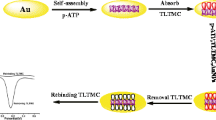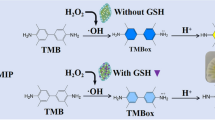Abstract
A fluorescent sensing material based on the ternary core–shell quantum dots with outstanding optical properties and a bio-inspired molecularly imprinted polymer (MIP) as a recognition element has been prepared for selective detection of rifampicin (RFP). Firstly, AgInS2/ZnS core/shell quantum dots (ZAIS QDs) were prepared by a hydrothermal process. Then, the fluorescent sensor was prepared by coating these QDs by a dopamine-based MIP layer. The fluorescence of MIP@ZAIS QDs was quenched by RFP probably due to the photoinduced electron transfer process. The quenching constant was much higher for MIP@ZAIS QDs than the non-imprinted polymer@QDs, indicating that MIP@ZAIS QDs could selectively recognize RFP. Under the optimized conditions, the sensor had a good linear relationship at the RFP concentration range of 5.0 to 300 nM and the limit of detection was 1.25 nM. The respond time of the MIP@ZAIS QDs was 5 min, and the imprinting factor was 6.3. It also showed good recoveries ranging from 98 to 101%, for analysis of human plasma samples. The method is simple and effective for the detection of RFP and offers a practical application for the rapid analysis of human plasma samples.
Graphical Abstract






Similar content being viewed by others
References
L. Li, T.J. Daou, I. Texier, T.T. Kim Chi, N.Q. Liem, P. Reiss, Highly luminescent CuInS2/ZnS core/shell nanocrystals: cadmium-free quantum dots for in vivo imaging. Chem. Mater. 21, 2422–2429 (2009). https://doi.org/10.1021/cm900103b
A. Delices, D. Moodelly, C. Hurot, Y. Hou, W.L. Ling, C. Saint-Pierre, D. Gasparutto, G. Nogues, P. Reiss, K. Kheng, Aqueous synthesis of DNA-functionalized near-infrared AgInS2/ZnS core/shell quantum dots. ACS Appl. Mater. Interfaces. 12, 44026–44038 (2020). https://doi.org/10.1021/acsami.0c11337
R. Muñoz, E.M. Santos, C.A. Galan-Vidal, J.M. Miranda, A. Lopez-Santamarina, J.A. Rodriguez, Ternary quantum dots in chemical analysis. Synthesis and detection mechanisms. Molecules 26, 2764 (2021). https://doi.org/10.3390/molecules26092764
F. Rasoulzadeh, M. Amjadi, The chemiluminescence of AgInS2 quantum dots and its application as a sensing platform for glutathione assay. J. Photochem. Photobiol. A Chem. 420, 113493 (2021). https://doi.org/10.1016/j.jphotochem.2021.113493
G. Kaur, S. Tripathi, Probing photoluminescence dynamics of colloidal CdSe/ZnS core/shell nanoparticles. J. Lumin. 155, 330–337 (2014). https://doi.org/10.1016/j.jlumin.2014.06.052
J. Park, C. Dvoracek, K.H. Lee, J.F. Galloway, H.C. Bhang, M.G. Pomper, P.C. Searson, CuInSe/ZnS core/shell NIR quantum dots for biomedical imaging. Small 7, 3148–3152 (2011). https://doi.org/10.1002/smll.201101558
D. Deng, L. Qu, Y. Gu, Near-infrared broadly emissive AgInSe 2/ZnS quantum dots for biomedical optical imaging. J. Mater. Chem. C 2, 7077–7085 (2014). https://doi.org/10.1039/C4TC01147C
A. Shamirian, O. Appelbe, Q. Zhang, B. Ganesh, S.J. Kron, P.T. Snee, A toolkit for bioimaging using near-infrared AgInS 2/ZnS quantum dots. J. Mater. Chem. B 3, 8188–8196 (2015). https://doi.org/10.1039/C5TB00247H
X. An, Y. Zhang, J. Wang, D.-M. Kong, X.-W. He, L. Chen, Y. Zhang, The preparation of CuInS2-ZnS-glutathione quantum dots and their application on the sensitive determination of cytochrome c and imaging of HeLa cells. ACS Omega 6, 17501–17509 (2021). https://doi.org/10.1021/acsomega.1c01983
X. Wang, S. Yu, W. Liu, L. Fu, Y. Wang, J. Li, L. Chen, Molecular imprinting based hybrid ratiometric fluorescence sensor for the visual determination of bovine hemoglobin. Acs Sensors 3, 378–385 (2018). https://doi.org/10.1021/acssensors.7b00804
J. Yu, X. Wang, Q. Kang, J. Li, D. Shen, L. Chen, One-pot synthesis of a quantum dot-based molecular imprinting nanosensor for highly selective and sensitive fluorescence detection of 4-nitrophenol in environmental waters, environmental science. NANO 4, 493–502 (2017). https://doi.org/10.1039/C6EN00395H
N. Nawaz, N.K.A. Bakar, H.N.M.E. Mahmud, N.S. Jamaludin, Molecularly imprinted polymers-based DNA biosensors. Anal. Biochem. 630, 114328 (2021). https://doi.org/10.1016/j.ab.2021.114328
C. Dong, H. Shi, Y. Han, Y. Yang, R. Wang, J. Men, Molecularly imprinted polymers by the surface imprinting technique. Eur. Polymer J. 145, 110231 (2021). https://doi.org/10.1016/j.eurpolymj.2020.110231
C.I. Lin, A.K. Joseph, C.K. Chang, Y. Der Lee, Molecularly imprinted polymeric film on semiconductor nanoparticles: analyte detection by quantum dot photoluminescence. J. Chromatogr. A 1027, 259–262 (2004). https://doi.org/10.1016/j.chroma.2003.10.037
Y. Saylan, F. Yilmaz, E. Özgür, A. Derazshamshir, H. Yavuz, A. Denizli, Molecular imprinting of macromolecules for sensor applications. Sensors 17, 898 (2017). https://doi.org/10.3390/s17040898
Z. Zhang, J. Li, X. Wang, D. Shen, L. Chen, Quantum dots based mesoporous structured imprinting microspheres for the sensitive fluorescent detection of phycocyanin. ACS Appl. Mater. Interfaces 7, 9118–27 (2015). https://doi.org/10.1021/acsami.5b00908
W. Li, Y. Sun, C. Yang, X. Yan, H. Guo, G. Fu, Fabrication of surface protein-imprinted nanoparticles using a metal chelating monomer via aqueous precipitation polymerization. ACS Appl. Mater. Interfaces. 7, 27188–27196 (2015). https://doi.org/10.1021/acsami.5b07946
D.-Y. Li, X.-M. Zhang, Y.-J. Yan, X.-W. He, W.-Y. Li, Y.-K. Zhang, Thermo-sensitive imprinted polymer embedded carbon dots using epitope approach. Biosens. Bioelectron. 79, 187–192 (2016). https://doi.org/10.1016/j.bios.2015.12.016
L. Li, Y. Lu, Z. Bie, H.Y. Chen, Z. Liu, Photolithographic boronate affinity molecular imprinting: a general and facile approach for glycoprotein imprinting. Angew. Chem. 125, 7599–7602 (2013). https://doi.org/10.1002/ange.201207950
S. Wang, J. Ye, Z. Bie, Z. Liu, Affinity-tunable specific recognition of glycoproteins via boronate affinity-based controllable oriented surface imprinting. Chem. Sci. 5, 1135–1140 (2014). https://doi.org/10.1039/C3SC52986J
G. Sharma, B. Kandasubramanian, Molecularly imprinted polymers for selective recognition and extraction of heavy metal ions and toxic dyes. J. Chem. Eng. Data 65, 396–418 (2020). https://doi.org/10.1021/acs.jced.9b00953
M. Jia, L. Qin, X.-W. He, W.-Y. Li, Preparation and application of lysozyme imprinted monolithic column with dopamine as the functional monomer. J. Mater. Chem. 22, 707–713 (2012). https://doi.org/10.1039/C1JM13134F
V.K. Thakur, J. Yan, M.-F. Lin, C. Zhi, D. Golberg, Y. Bando, R. Sim, P.S. Lee, Novel polymer nanocomposites from bioinspired green aqueous functionalization of BNNTs. Polym. Chem. 3, 962–969 (2012). https://doi.org/10.1039/C2PY00612J
D. Lemus, A. Martin, E. Montoro, F. Portaels, J.C. Palomino, Rapid alternative methods for detection of rifampicin resistance in Mycobacterium tuberculosis. J. Antimicrob. Chemother. 54, 130–133 (2004). https://doi.org/10.1093/jac/dkh320
K. Chatterjee, C.W. Kuo, A. Chen, P. Chen, Detection of residual rifampicin in urine via fluorescence quenching of gold nanoclusters on paper. J. Nanobiotechnol. 13, 1–9 (2015). https://doi.org/10.1186/s12951-015-0105-5
Y. Cui, A. Su, J. Feng, W. Dong, J. Li, H. Wang, X. Ni, Y. Jiang, Development of silica molecularly imprinted polymer on carbon dots as a fluorescence probe for selective and sensitive determination of cetirizine in saliva and urine. Spectrochim. Acta Part A Mol. Biomol. Spectrosc. 264, 120293 (2022). https://doi.org/10.1016/j.saa.2021.120293
X.-M. Wu, J.-H. Zhang, Z.-S. Feng, W.-X. Chen, F. Zhang, Y. Li, An ultra-sensitive “turn-off” fluorescent sensor for the trace detection of rifampicin based on glutathione-stabilized copper nanoclusters. Analyst 145, 1227–1235 (2020). https://doi.org/10.1039/C9AN01994D
Z. Han, Y. Long, S. Pan, H. Liu, J. Yang, X. Hu, Efficient one-pot synthesis of carbon dots as a fluorescent probe for the selective and sensitive detection of rifampicin based on the inner filter effect. Anal. Methods 10, 4085–4093 (2018). https://doi.org/10.1039/C8AY01385C
R. Jalili, M. Amjadi, Bio-inspired molecularly imprinted polymer–green emitting carbon dot composite for selective and sensitive detection of 3-nitrotyrosine as a biomarker. Sens. Actuators, B Chem. 255, 1072–1078 (2018). https://doi.org/10.1016/j.snb.2017.08.145
X. Kang, L. Huang, Y. Yang, D. Pan, Scaling up the aqueous synthesis of visible light emitting multinary AgInS2/ZnS core/shell quantum dots. J. Phys. Chem. C 119, 7933–7940 (2015). https://doi.org/10.1021/acs.jpcc.5b00413
B. Feng, Z. Xu, L. Gai, Water-soluble organic polymer/silica composite nanofilms with improved fluorescence quantum yield. J. Lumin. 211, 347–354 (2019). https://doi.org/10.1016/j.jlumin.2019.03.066
V. Anbazhagan, R. Renganathan, Study on the binding of 2,3-diazabicyclo[2.2.2]oct-2-ene with bovine serum albumin by fluorescence spectroscopy. J. Lumin. 128, 1454–1458 (2008). https://doi.org/10.1016/j.jlumin.2008.02.004
C.-X. Liu, J. Zhao, R.-R. Zhang, Z.-M. Zhang, J.-J. Xu, A.-L. Sun, J. Chen, X.-Z. Shi, Development and application of fluorescence sensor and test strip based on molecularly imprinted quantum dots for the selective and sensitive detection of propanil in fish and seawater samples. J. Hazard. Mater. 389, 121884 (2020). https://doi.org/10.1016/j.jhazmat.2019.121884
B.D. Bozorg, A. Goodarzi, F. Fahimi, P. Tabarsi, N. Shahsavari, F. Kobarfard, Dastan, Simultaneous determination of isoniazid, pyrazinamide and rifampin in human plasma by high-performance liquid chromatography and UV detection. Iran. J. Pharm. Res. IJPR. 18, 1735 (2019). https://doi.org/10.22037/ijpr.2019.1100849
A. Srivastava, D. Waterhouse, A. Ardrey, S.A. Ward, Quantification of rifampicin in human plasma and cerebrospinal fluid by a highly sensitive and rapid liquid chromatographic–tandem mass spectrometric method. J. Pharm. Biomed. Anal. 70, 523–528 (2012). https://doi.org/10.1016/j.jpba.2012.05.028
A. Allanson, M. Cotton, J. Tettey, A. Boyter, Determination of rifampicin in human plasma and blood spots by high performance liquid chromatography with UV detection: a potential method for therapeutic drug monitoring. J. Pharm. Biomed. Anal. 44, 963–969 (2007). https://doi.org/10.1016/j.jpba.2007.04.007
Y. Ma, B.T. Zhang, L.X. Zhao, G.S. Guo, J.M. Lin, Determination of rifampicin by peroxomonosulfate-cobalt (II) chemiluminescence system. Chin. J. Chem. 26, 905–10 (2008). https://doi.org/10.1002/cjoc.200890166
Author information
Authors and Affiliations
Corresponding author
Ethics declarations
Conflicts of interest
There are no conflicts to declare.
Supplementary Information
Below is the link to the electronic supplementary material.
Rights and permissions
Springer Nature or its licensor (e.g. a society or other partner) holds exclusive rights to this article under a publishing agreement with the author(s) or other rightsholder(s); author self-archiving of the accepted manuscript version of this article is solely governed by the terms of such publishing agreement and applicable law.
About this article
Cite this article
Rasoulzadeh, F., Amjadi, M. A novel fluorescent sensor for selective rifampicin detection based on the bio-inspired molecularly imprinted polymer-AgInS2/ZnS quantum dots. ANAL. SCI. (2024). https://doi.org/10.1007/s44211-024-00512-y
Received:
Accepted:
Published:
DOI: https://doi.org/10.1007/s44211-024-00512-y




